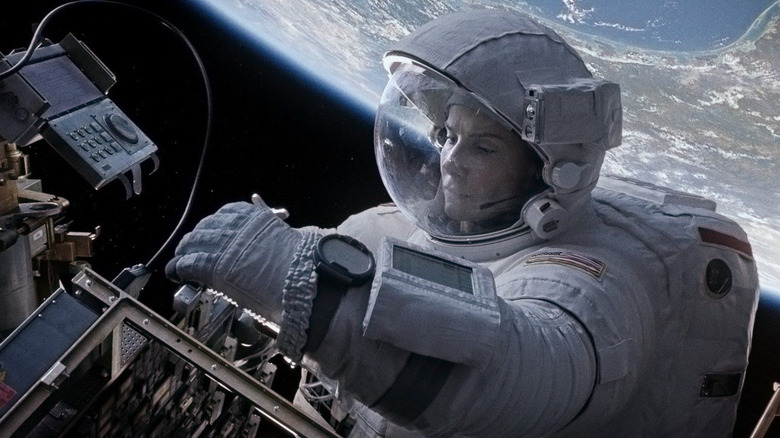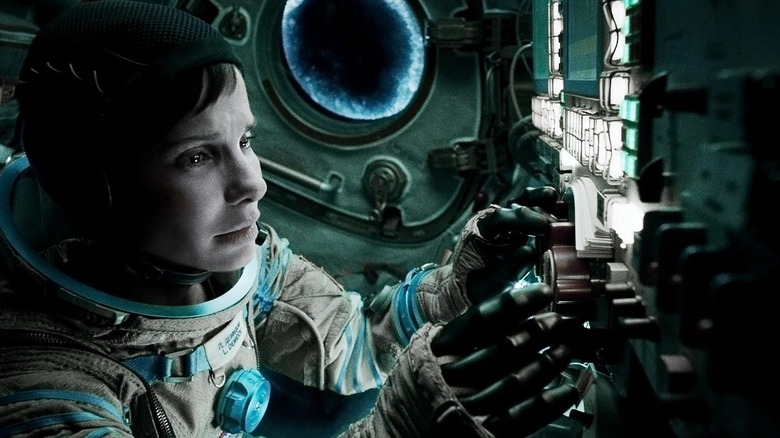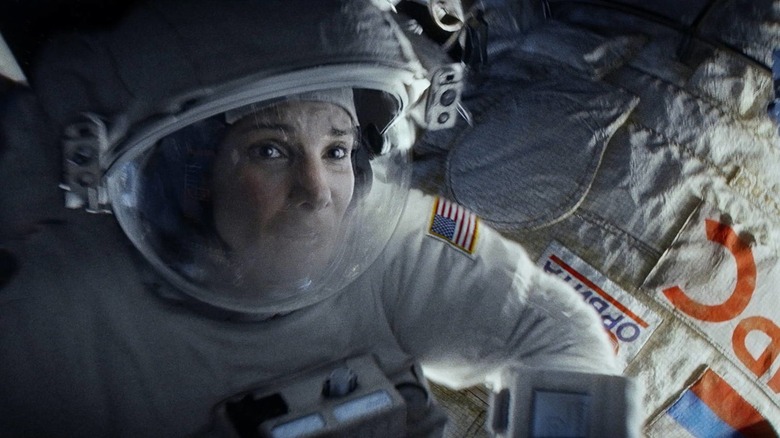Shooting Gravity Kept Sandra Bullock Isolated Up To Eleven Hours A Day
In space, no one can hear you scream when Russians shoot down a spy satellite, causing a cloud of debris that destroys the International Space Station where you happen to be on board. In the spectacular opening sequence of Alfonso Cuarón's "Gravity," starring Sandra Bullock and George Clooney, a phenomenon known as a Kessler Syndrome catastrophe takes place when space pollution tears into the modules, trusses, and solar arrays of the ISS in a sudden, terrifying accident.
Bullock's character, Ryan Stone, is sent hurtling out into the deep reaches of space. Understandably, she's panicked, disoriented, and deeply shaken. In a hostile environment where sound doesn't travel due to the lack of oxygen, all Stone can hear is the deep gulps of breath she's taking and the sound of her own rapid heartbeat. Stone is utterly alone, foreshadowing her isolation and self-reliance later on in "Gravity" where she has to overcome impossible odds in order to safely crash land back on Earth.
No stranger to effects-heavy, game-changing blockbusters, James Cameron called "Gravity" the best space film ever done. David Fincher also told Cuarón and cinematographer Emmanuel Lubezki to wait five years for the technology to catch up with what they wanted to achieve. Lo and behold, it took almost five years to complete the film. Cuarón and his team created the "Light Box" — a 360-degree rig of Jumbotron screens made up of 1.8 million individually controllable LED bulbs. Also referred to as "Sandy's Box" during the exhausting shoot, the ingenious invention used a piloted robotic camera to give the illusion that Bullock was moving through space. The entire process led to real bouts of panic and claustrophobia for Bullock who was isolated at times for up to 11 hours a day.
'I was Houston and she was the astronaut'
With a technical setup that wound up mirroring the communications between a stranded astronaut and Mission Control, Cuarón corresponded with Bullock through hidden headphones in her suit during filming. "Poor Sandra, she was alone there in that box," Cuarón told Rolling Stone back in 2013. "I was literally 15 minutes away, with banks of computers and stuff, communicating with her through radio, like I was Houston and she was an astronaut."
As the minimal cast and crew started to get into the flow of production, it became too cumbersome and time-consuming for Bullock to repeatedly enter and exit the Light Box. In a practical but still brave decision, Bullock chose to stay strapped inside the state-of-the-art rig for incredibly long periods of time. To open the cube and close it again would take up to 25 minutes. Add on all of the endless adjustments, calibrations, and general troubleshooting, and Bullock's resolve allowed for the tension to keep ramping up instead of dissipating every time the cube had to reset.
To help brighten her mood during the long days, Cuarón would beam calming, atmospheric music into Bullock's headphones and occasionally surprise her by lighting up the massive array of LED screens with images of her kid. For all the sacrifice and cramped conditions that Bullock endured, the Light Box was still relatively safe and she was never in any real danger. After battling long hours and claustrophobia, there was one day in particular, however, that stood out to Bullock where she was legitimately concerned for her safety.
'It felt like minutes before they got to me'
One day during a sequence featuring an underwater tank, things turned for the worst when Bullock felt trapped, suddenly. "I had to get out of the space suit underwater, and I started to panic because I couldn't get out fast enough," Bullock told Rolling Stone. "The rescue divers were far away because of how wide the shot was, and it felt like minutes before they got to me." The sequence takes place after Stone regains access to the ISS via an airlock. Floating weightless, she removes her space suit for a moment of calm before she's forced to put out a fire onboard. If you look closely at Bullock's face, it does look like she's underwater during the scene.
Originally, Bullock may not have had to endure the physical and emotional toll and lengthy shoot of "Gravity" at all. Angelina Jolie was set to play Stone at one point, with Robert Downey, Jr. contracted to portray Mission Commander Matt Kowalski. Some executives even argued for a male star to play Stone, a suggestion that Cuarón quickly pushed back on. "We wanted to stay completely away from macho heroism," he said. Bullock was primed to take the role at that point in her career after winning the Oscar for Best Actress for "The Blind Side." Bullock was looking for a real challenge, and she delivered, giving an expressive performance that demanded physicality and a deep level of vulnerability. Stone is going through an internal crisis in "Gravity" and an improbable external crisis, simultaneously.
Cuarón admitted that he was concerned about realism when Bullock said that Stone should never scream. "I said, 'Sandra, I would scream if I was there.' She said, 'Yes, but you're a wimp.'"


